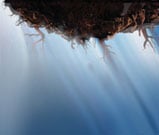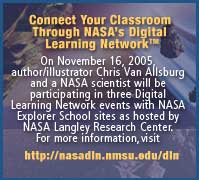 |
Lesson Plan: Comet Facts, Myths, and Legends

 
Classrooms Without Computers
Here are some suggestions:1. If you have access to a computer with Internet capabilities at home or in the school library, you may print selected parts of the activity as paper copies or transparencies. 2. If your school has one or more computers located outside your classroom, students may experience the activity individually or in small groups as a learning station. 3. Some students might have computers at home with access to the Internet. If that's the case, you might consider assigning “Comet Facts, Myths, and Legends” as homework or extra credit. 4. Through the Educator Resource Center Network, NASA provides the expertise and necessary facilities to help educators access and utilize science, mathematics, technology, and geography instructional products. Execution
Time
The amount of time needed to complete this activity will vary, depending
on the length of available teaching time, the ratio of computers to students
in the class, and what you have your students do. Estimated 20 minutes for
students to read “Comet
Facts, Myths, and Legends” and 40 minutes to complete activities.Materials
This activity requires a computer with a color monitor and Internet connection.
The Web browser must be capable of running Netscape's Navigator 3.0 (or
better) or Internet Explorer 4.0 (or better).Procedure/Directions
This is a self-directed computer activity. Suggested enhancements: 1. Project images of comets from the Space Telescope Science Institute's Web site onto a screen or television monitor. In a class discussion, ask students to describe what they already know about comets and planets, and what they can learn from the images. 2. Organize an informal debate or discussion on the topic “Comet Collisions with Earth: Fact or Myth?” Evaluation/Assessment
Share the learning outcomes with your students ahead of time. Then, following the reading, distribute Reproducible 3, Identifying Comets (PDF), and Reproducible 4, Truth or Fiction? (PDF) Answer Key
Reproducible 3:1. Some possible answers include: Comets travel far beyond the orbit of the Moon. Comets move in elliptical orbits around the Sun. Comets return to the inner Solar System at predictable times. Edmund Halley correctly predicted the return of the comet named for him. Comets leave a trail of debris behind them. For a long time afterward, whenever the Earth passes through the left-behind trails, the debris strikes our atmosphere and causes meteor showers. 2. Some possible answers include: Some people in ancient times thought that a comet was a curse. To save himself from the “curse of the comet,” Emperor Nero of Rome had all possible successors to his throne executed. The famous Bayeux Tapestry, which commemorates the Norman Conquest of England in 1066, depicts an image of Halley's Comet bright in the sky before the Battle of Hastings. Some people thought this meant that King Harold would lose his throne to William, the Duke of Normandy. He did. 3. Some possible answers include: Most astronomers in the 1500's and early 1600's thought that a comet appeared once and was never seen again. They believed that a comet approached the Sun in a straight line, spun around it, and then disappeared into space in a straight path. Another myth claims that the gas from a comet tail is poisonous and can affect people on Earth if its path crosses the planet. 4. Students will probably identify the tail as the primary feature that makes comets visible. Comets have bright tails when near the Sun—this makes them visible. Comets are composed of ice and dust, which changes to gas when their elliptical orbits bring them close to the Sun. The gas creates a coma and flowing tail(s). 5. Comets move in orbits around the Sun. Since the path is a complete oval, comets return to the inner Solar System at predictable times. 6. Comets from the Kuiper Belt tend to have short periods—like Halley's Comet, which reappears every 76 years, or comet Swift-Tuttle, which reappears every 120 years. Comets from the Oort Cloud tend to have long periods, like Comet Hale-Bopp with its 2,400-year period, or Hyakutake, which will not appear again for another 14,000 years. Teaching
with the Poster
There are all kinds of objects that orbit the Earth, the Sun, and other planets. Could a house launch into orbit, as the poster depicts? Could it travel through space? Show students the poster, and encourage them to come up with questions the image raises. (How much force is required to lift a house that far into space? How fast would the house need to be traveling, and in what direction? What would prevent the house from burning up in our atmosphere?) While you discuss these questions, keep track of science topics raised in the discussion. Keep a list on the board. Areas of interest might include: acceleration, satellite, meteor, asteroid, orbit, gravity, jet propulsion, and velocity. Students can then visit www.nasa.gov to conduct research and explore their questions. Additional Teacher Resources Visit www.Zathura.net for a language arts lesson plan based on Zathura, plus links to other lesson plans on books by Chris Van Allsbur. Photo Credits: ZATHURA: The Movie © 2005
Columbia Pictures Industries, Inc. All Rights Reserved. © 2005 Columbia Tristar Marketing Group, Inc. All Rights Reserved. You will need Adobe Acrobat Reader® software, version 4.0 or higher
to view and print items marked PDF. |
     |


